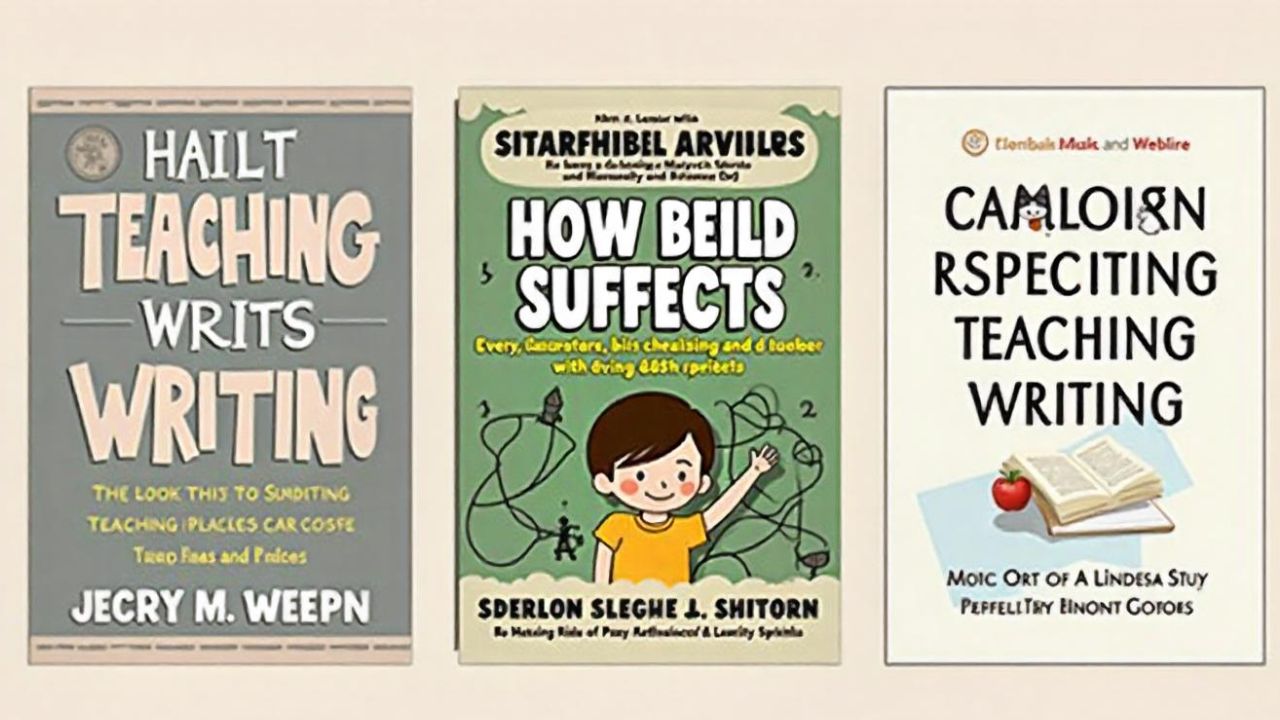
Books on Teaching Writing
Teaching writing requires more than grammar drills and red ink. Teachers need reliable strategies, engaging methods, and thoughtful guidance. Choosing the right books on teaching writing gives educators those tools. These books provide practical frameworks, creative prompts, and research-backed techniques that transform students into confident, effective writers.
Why Teachers Need Books on Teaching Writing
Every writer, no matter their age, benefits from structured support. Writing instruction calls for clear models, consistent feedback, and ample creativity. Books that focus on writing pedagogy help teachers understand how to scaffold writing experiences across grade levels and learning needs.
Strong books on teaching writing often combine classroom stories, theory, and lesson plans. These resources speak directly to educators’ challenges. Teachers use them to build stronger curriculum plans, reach reluctant writers, and inspire their classrooms with purpose and passion.
Qualities to Look for in a Writing Instruction Book
Not every book works equally for every teacher. When selecting a resource, consider these features:
-
Clear teaching frameworks with adaptable lesson plans
-
Strategies that align with curriculum standards
-
Insights into the writing process and student development
-
Practical tools for assessment and feedback
-
Examples of student writing across genres and ages
-
Encouragement for building a classroom writing community
Books that meet these criteria usually provide long-lasting value and consistent results.
Top Recommended Books on Teaching Writing
Many excellent titles exist in the world of writing instruction. Below are some of the most trusted and beloved books for teaching writing at any level.
1. “Writing Workshop: The Essential Guide” by Ralph Fletcher and JoAnn Portalupi
This classic lays the groundwork for running a writer’s workshop. The authors explain how to create a writing-friendly classroom, schedule daily writing time, and respond to students effectively. They include sample lessons and helpful anecdotes to illustrate the importance of student voice and choice.
2. “The Writing Strategies Book” by Jennifer Serravallo
Serravallo organizes over 300 writing strategies by skill and developmental level. Teachers can quickly find a strategy to match any student need. She includes visuals, anchor charts, and writing samples to guide both new and experienced educators.
3. “Mechanically Inclined” by Jeff Anderson
Anderson offers a humorous, engaging look at how to teach grammar and mechanics in context. Rather than isolating rules, he shows how to embed them into real writing. The book includes mentor sentences, mini-lessons, and classroom routines that encourage grammar confidence.
4. “About the Authors” by Katie Wood Ray and Lisa B. Cleaveland
This book targets early elementary educators. It focuses on helping young children discover their identities as writers. The authors share methods for teaching narrative structure, encouraging student voice, and using published books as mentor texts.
5. “Teaching Adolescent Writers” by Kelly Gallagher
Gallagher writes with passion and urgency. He shares real classroom strategies that engage middle and high school writers. His focus includes writing volume, modeling, and the six pillars of writing instruction. Gallagher’s insights come from decades of teaching in real classrooms.
6. “In the Middle” by Nancie Atwell
Atwell combines research and experience in this foundational work. She outlines her classroom practices for reading and writing workshops. Teachers learn how to support student choice, give feedback, and foster independence. Many educators consider this book a must-read.
7. “Write Beside Them” by Penny Kittle
Kittle advocates writing with students, not just assigning tasks. She models how to build trust, choose meaningful prompts, and support revision. Her book includes real examples of student writing and teacher reflections.
8. “Because Writing Matters” by the National Writing Project
This collaborative book provides a research-based argument for prioritizing writing instruction. It explores how writing improves learning in all subjects. The book also includes professional development ideas for educators and administrators.
Books That Focus on Specific Writing Genres
In addition to general instruction guides, some books focus on teaching specific genres. These targeted resources help teachers explore narrative, persuasive, informational, and poetic writing.
-
“Crafting Nonfiction” by Linda Hoyt and Tony Stead: This book helps students become researchers and nonfiction authors.
-
“The Big Book of Details” by Rozlyn Linder: Offers craft lessons focused on improving descriptive and narrative writing.
-
“Teaching Argument Writing” by George Hillocks: A thorough resource for teaching logic, reasoning, and persuasive structure in writing.
Genre-specific books enrich classroom instruction by breaking down complex writing tasks into manageable steps.
Integrating Mentor Texts with Writing Instruction
Many top writing instruction books highlight the importance of mentor texts. These published pieces model strong writing. Teachers use them to show students how writers make decisions with purpose.
Books that promote mentor text use include:
-
“Everyday Editing” by Jeff Anderson
-
“What a Writer Needs” by Ralph Fletcher
-
“Notebook Know-How” by Aimee Buckner
Mentor texts give students inspiration and structure. When used correctly, they help students see writing as both craft and art.
Professional Development Through Writing Books
Teachers who want to grow in their craft often turn to books for professional development. Reading about writing instruction keeps educators inspired and informed.
You might consider:
-
Starting a book study group with colleagues
-
Choosing a summer reading goal focused on writing pedagogy
-
Attending conferences that feature these authors as speakers
Lifelong learning makes teaching writing more enjoyable and effective.
Supporting Struggling Writers With Targeted Strategies
Several books address the needs of students who find writing difficult. These resources offer modified lessons, graphic organizers, and alternative methods.
-
“Strategies for Struggling Writers” by James Collins: Packed with scaffolds and mini-lessons.
-
“Scaffolding Young Writers” by Linda Dorn and Tammy Jones: Explores developmental writing stages in early education.
-
“Teaching Writing Through Differentiated Instruction” by Roberta Sejnost: Helps tailor instruction for diverse learners.
Understanding student challenges allows teachers to respond with empathy and effective strategies.
Assessment Tools Included in Writing Books
Writing instruction requires thoughtful assessment. Books that offer rubrics, checklists, and student reflection tools support the full cycle of instruction.
Look for:
-
Peer review guides
-
Self-assessment checklists
-
Growth portfolios
-
Rubrics aligned with standards
Books like “Assessing Writers” by Carl Anderson explain how to give formative and summative feedback that builds student confidence.
FAQs About Books on Teaching Writing
1. How do I choose the right book for my classroom?
Consider your grade level, teaching style, and curriculum needs. Start with a foundational guide, then explore specialized resources.
2. Are these books only for English teachers?
No. Teachers of all subjects benefit from learning how to support student writing. Writing enhances learning in every discipline.
3. Can I use these books with digital or remote teaching?
Yes. Many books include digital resources or strategies that adapt easily to online classrooms and hybrid learning models.
4. Should I read multiple books on writing instruction?
Absolutely. Each author offers a unique perspective. Reading several books gives you a well-rounded teaching toolkit.
5. Are these books appropriate for homeschooling parents?
Yes. Many books are written in a conversational tone and include examples that apply to home learning environments.
6. Do these books include lesson plans?
Most of them do. You’ll find detailed activities, models, and guidance for daily, weekly, or unit-based lessons.
Final Thoughts: The Power of Books on Teaching Writing
Strong writing instruction transforms students into thinkers, communicators, and creators. The best books on teaching writing give educators the tools to inspire that transformation. Whether you teach elementary schoolers or high school seniors, these books provide ideas, frameworks, and encouragement.
Writing becomes more than just an assignment—it becomes a process of discovery. By choosing high-quality resources, teachers build classrooms where every student can find their voice, develop skills, and enjoy the writing journey. Keep learning, keep teaching, and keep writing—because your students deserve nothing less.







